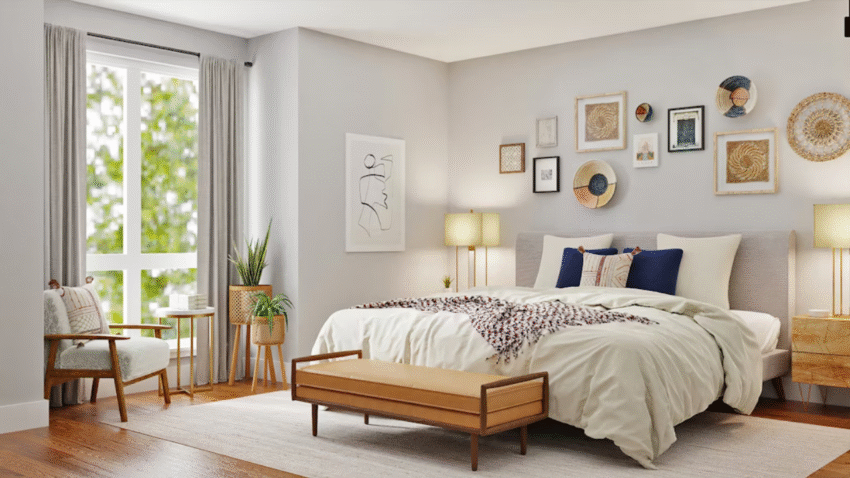Introduction
Shopping for a new bed but not sure what size is best? Figuring out how to choose the right size bed for your room can be surprisingly tricky. Go too big, and your bedroom feels cramped and hard to move around. Go too small, and you might sacrifice comfort and regret it every night. A well-sized bed balances comfort, flow, and style—turning your bedroom into a restful retreat instead of a cluttered obstacle course.
Why Bed Size Matters in the Bedroom
Your bed is the largest piece of furniture in your bedroom, so its size dramatically affects your space’s layout, functionality, and comfort. The right size bed provides enough room to stretch out while leaving space to walk around, open drawers, and breathe easy. Good flow around your bed makes cleaning simpler and your whole bedroom feel calm and balanced. Choosing the right size bed also helps you make the most of your bedroom’s natural light, storage solutions, and overall design.
Step-by-Step Guide to Choose the Right Size Bed for Your Room
1. Measure Your Bedroom First
Before you fall in love with a California King, grab your tape measure. Measure the length and width of your bedroom, then note the position of windows, closets, doors, and built-ins. Don’t forget to check how doors swing open—this is crucial for planning where the bed will go.
2. Know Standard Bed Sizes
Here’s a quick refresher on common mattress sizes (dimensions may vary slightly by brand):
- Twin: 38” x 75” – Best for kids, small guest rooms, or very tight spaces.
- Twin XL: 38” x 80” – Extra legroom for taller sleepers.
- Full (Double): 54” x 75” – Good for solo sleepers who want more space.
- Queen: 60” x 80” – Most popular choice for couples or solo sleepers who like to spread out.
- King: 76” x 80” – Great for couples who want maximum room, but needs more floor space.
- California King: 72” x 84” – Extra length for tall people, but slightly narrower than a regular King.
3. Use the “Two-Feet Rule”
Interior designers swear by this simple guideline: leave at least 24–36 inches of clearance on each side of the bed and at the foot of the bed. This ensures you can walk around comfortably, open drawers, and make the bed without bumping into walls or furniture.
4. Consider Your Sleep Needs
Your lifestyle matters too:
- Do you sleep alone or with a partner?
- Do kids or pets join you at night?
- Do you toss and turn or need extra space to stretch out?
If you share your bed, a Queen or King is usually more comfortable. Solo sleepers in small rooms can do fine with a Full or even a Twin XL.
5. Think About Room Layout and Flow
Look at where your bed will go. Ideally, the head of your bed should be against the longest uninterrupted wall. Avoid blocking windows or walkways. A bed that’s too big might fit on paper but ruin the room’s flow. Use painter’s tape to outline the mattress size on the floor so you can see exactly how it feels in the space.
6. Factor In Nightstands and Other Furniture
Don’t forget the other essentials:
- Nightstands usually need 18–24 inches of width each.
- Dressers, desks, or chairs all need clearances for drawers and seating.
- Rugs should extend at least 18–24 inches beyond the bed for a balanced look.
Make sure your bed size leaves room for these items without crowding your pathways.
7. Don’t Overwhelm Small Rooms
A King bed in a tiny bedroom can make your sanctuary feel more like a storage closet. If your room is under 10×10 feet, a Full or Queen is usually a better fit. Leave yourself enough open floor space so you can move freely and maintain good airflow for better sleep hygiene.
8. Consider Ceiling Height and Scale
If your room has low ceilings, an oversized bed with a tall headboard can make the space feel squat and cramped. Opt for a lower-profile bed frame in smaller or shorter rooms. In a large master bedroom with high ceilings, a bigger bed and a bold headboard help the space feel cozy instead of empty.
Common Mistakes to Avoid
Mistake 1: Ignoring clearance space.
Solution: Always leave at least two feet on each side and at the foot of the bed for easy access.
Mistake 2: Forgetting about furniture placement.
Solution: Measure nightstands, dressers, and rugs to make sure they fit well with your bed.
Mistake 3: Overestimating the space.
Solution: Tape out the bed’s dimensions on the floor to see exactly how much room you’ll have left.
Mistake 4: Choosing based only on sleep comfort.
Solution: Balance sleep comfort with practical room flow—an oversized bed can ruin a peaceful vibe if you can’t move around it.
Mistake 5: Blocking windows or doors.
Solution: Always check where windows, doors, and closet doors open so you don’t accidentally box yourself in.
Extra Tips & Bedroom Hacks
- Try a Storage Bed: If you need a bigger bed but have a small room, a bed with built-in drawers underneath helps you save space.
- Keep It Light: Low-profile bed frames and lighter bedding colors can make a big bed feel less dominant in a tight space.
- Related Read: Ready to make the rest of your room flow? Check out How to Arrange Bedroom Furniture for Better Flow for more layout ideas.
Conclusion
Learning how to choose the right size bed for your room helps you strike the perfect balance between comfort and functionality. Take time to measure, consider your needs, and plan the layout before you buy. The right bed size will make your bedroom feel spacious, restful, and truly welcoming—just what you deserve after a long day. Bookmark this guide so you can come back to it anytime you’re ready to upgrade your sleep sanctuary.
